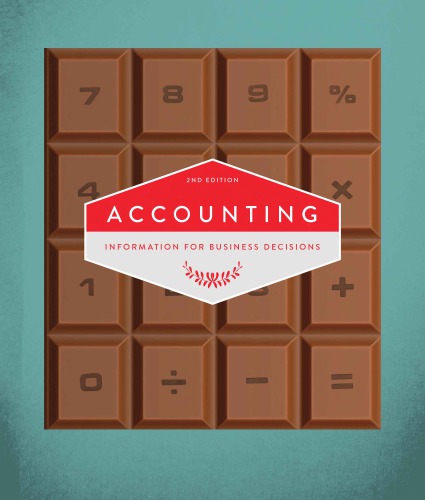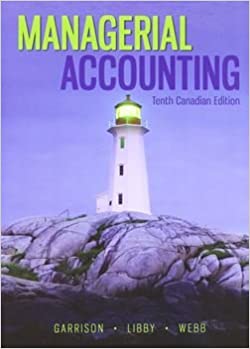Description
Test Bank For Accounting Information for Business Decisions 2nd Edition by Billie Cunningham
Chapter 3 – Developing a Business Plan: Budgeting
COMPLETION
1.A ____________________ is a report that gives a financial description of one part of a business’ planned activities.
ANS: budget
PTS: 1 DIF: Easy TOP: Why budget?
2.Using budgeting to describe a business’ plans allows the entrepreneur to uncover potential ___________________before they occur.
ANS: problems
PTS: 1 DIF: Easy TOP: Why budget?
3.Under _________________________, the entrepreneur periodically compares the results of the business’ actual operating activities with the related budget amounts, and focuses on improving the activities that show significant differences between actual and budget.
ANS: management by exception
PTS: 1 DIF: Moderate TOP: Budgeting creates benchmarks
4.A retail business’ ____________________ is the average time it takes the business to use cash to buy goods for sale, to sell these goods and to collect cash from its customers.
ANS: operating cycle
PTS: 1 DIF: Moderate TOP: The operating cycle of a retail business
5.____________________ is goods purchased for sale to customers.
ANS: Inventory
PTS: 1 DIF: Easy TOP: The operating cycle of a retail business
6.When businesses charge their purchases, these are called ____________________ purchases.
ANS: credit
PTS: 1 DIF: Easy TOP: The operating cycle of a retail business
7.When a business charges their purchases it results in ____________________.
ANS: accounts payable
PTS: 1 DIF: Easy TOP: The operating cycle of a retail business
8.When a business’ customers charge their purchases it results in ____________________.
ANS: accounts receivable
PTS: 1 DIF: Easy TOP: The operating cycle of a retail business
9.A ____________________ is a set of interrelated reports showing the relationships among a business’ goals, activities to be performed, resources to be used and expected financial results.
ANS: master budget
PTS: 1 DIF: Moderate TOP: The budget as a framework for planning
10.By the nature of their operations, a service business’ master budget does not include a ____________________ budget.
ANS: purchases
PTS: 1 DIF: Moderate TOP: The budget as a framework for planning
11.The ____________________ shows the number of units of inventory that the business expects to sell each month, the related monthly sales revenue, and the monthly cash collections from sales.
ANS: sales budget
PTS: 1 DIF: Easy TOP: The retail business’ sales budget
12.If a business allows credit sales, its ____________________ from accounts receivable will lag behind its sales revenue.
ANS: cash collections
PTS: 1 DIF: Moderate TOP: The retail business’ sales budget
13.Some businesses sales occur evenly throughout the year, while other businesses experience ____________________ sales.
ANS: seasonal
PTS: 1 DIF: Easy TOP: The retail business’ sales budget
14.The ____________________ shows the purchases in units required each month to make the expected sales and to keep inventory at the desired level.
ANS: purchases budget
PTS: 1 DIF: Easy TOP: The retail business’ purchases budget
15.The ____________________ shows the expenses and related cash payments associated with planned selling activities.
ANS: selling expenses budget
PTS: 1 DIF: Easy TOP: The retail business’ selling expenses budget
16.A projected____________________ summarises a business’ expected revenues and expenses for the budget period.
ANS: income statement
PTS: 1 DIF: Easy TOP: The projected income statement
17.Budgeting is a valuable tool for ____________________ how a business, division, department or team actually performed.
ANS: evaluating
PTS: 1 DIF: Moderate TOP: Using the master budget in evaluating the business’ performance
18.A manager can use information from the master budget to help to identify the causes of ____________________ between budgeted and actual expenses.
ANS: differences
PTS: 1 DIF: Easy TOP: Learning why differences occur
19.Differences between planned and actual results can have both ____________________ and_______________ consequences.
ANS: positive; negative
PTS: 1 DIF: Moderate TOP: Learning why differences occur
20.Businesses can build ____________________ into corporate budgeting and planning by following five basic principles.
ANS: sustainability
PTS: 1 DIF: Moderate TOP: Budgets, business issues and sustainability
TRUE/FALSE
1.Budgeting helps the entrepreneur recognise and avoid potential operating problems.
ANS: T PTS: 1 DIF: Easy TOP: Budgeting highlights potential problems
2.Budgeting will be most useful after the planning decisions have been implemented.
ANS: F PTS: 1 DIF: Easy TOP: Budgeting quantifies plans
3.In the operating cycle, credit sales of goods or services by a business result in accounts payable.
ANS: F PTS: 1: DIF: Moderate TOP: Operating cycles
4.In the operating cycle, credit purchases of goods or services by a business result in accounts payable.
ANS: T PTS: 1 DIF: Easy TOP: Operating cycles
5.The sales budget is the first component of the master budget.
ANS: T PTS: 1 DIF: Easy TOP: The budget as a framework for planning
6.The cash budget is the first component of the master budget.
ANS: F PTS: 1 DIF: Easy TOP: The budget as a framework for planning
7.The purchases budget is the first component of the master budget.
ANS: F PTS: 1 DIF: Moderate TOP: The budget as a framework for planning
8.The purchases budget shows the purchases required to meet the goals in the sales budget.
ANS: T PTS: 1 DIF: Moderate TOP: The retail business’ purchases budget
9.The purchases budget for a service business shows the purchases required to meet the goals in the sales budget.
ANS: F PTS: 1 DIF: Moderate TOP: The retail business’ purchases budget
10.In preparing the selling expenses budget, variable costs will be dependent on the projected units to be sold.
ANS: T PTS: 1 DIF: Moderate TOP: The retail business’ selling expenses budget
11.In preparing the selling expenses budget, fixed costs will be dependent on the projected units to be sold.
ANS: F PTS: 1 DIF: Moderate TOP: The retail business’ selling expenses budget
12.In preparing the selling expenses budget, variable costs will be independent of the projected units to be sold.
ANS: F PTS: 1 DIF: Moderate TOP: The retail business’ selling expenses budget
13.The general and administrative expenses budget indicates projected costs for activities other than selling activities.
ANS: T PTS: 1 DIF: Moderate TOP: The retail business’ general and administrative expenses budget
14. The cash budget shows the projected business revenues and expenses.
ANS: F PTS: 1 DIF: Moderate TOP: The retail business’ cash budget
15.The projected income statement is not the same as cash budget.
ANS: T PTS: 1 DIF: Easy TOP: The projected income statement
16.The cost report for a budget would not be prepared until after the budget had been implemented.
ANS: T PTS: 1 DIF: Moderate TOP: Using the master budget in evaluating the business performance
17.The cost report should be prepared after the budget is implemented to reveal any potential areas of concern.
ANS: T PTS: 1 DIF: Difficult TOP: Using the master budget in evaluating the business performance
18.Managers of all types of businesses use budgets as planning tools.
ANS: T PTS: 1 DIF: Moderate TOP: Using the master budget in evaluating the business performance
19.Comparing budgeted amounts to actual performance is not an important part of the budgeting process.
ANS: F PTS: 1 DIF: Moderated TOP: Learning why differences occur
20.The cost report would be useful for a manager practicing management by exception.
ANS: T PTS: 1 DIF: Difficult TOP: Learning why differences occur





Be the first to review “Test Bank For Accounting Information for Business Decisions 2nd Edition by Billie Cunningham”